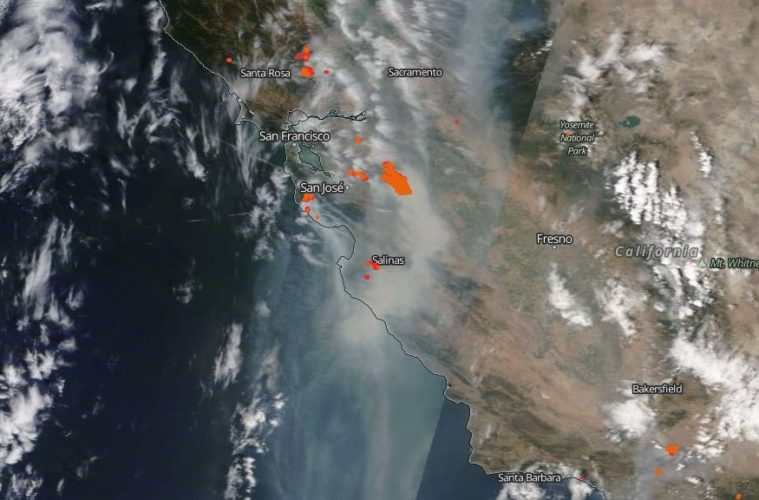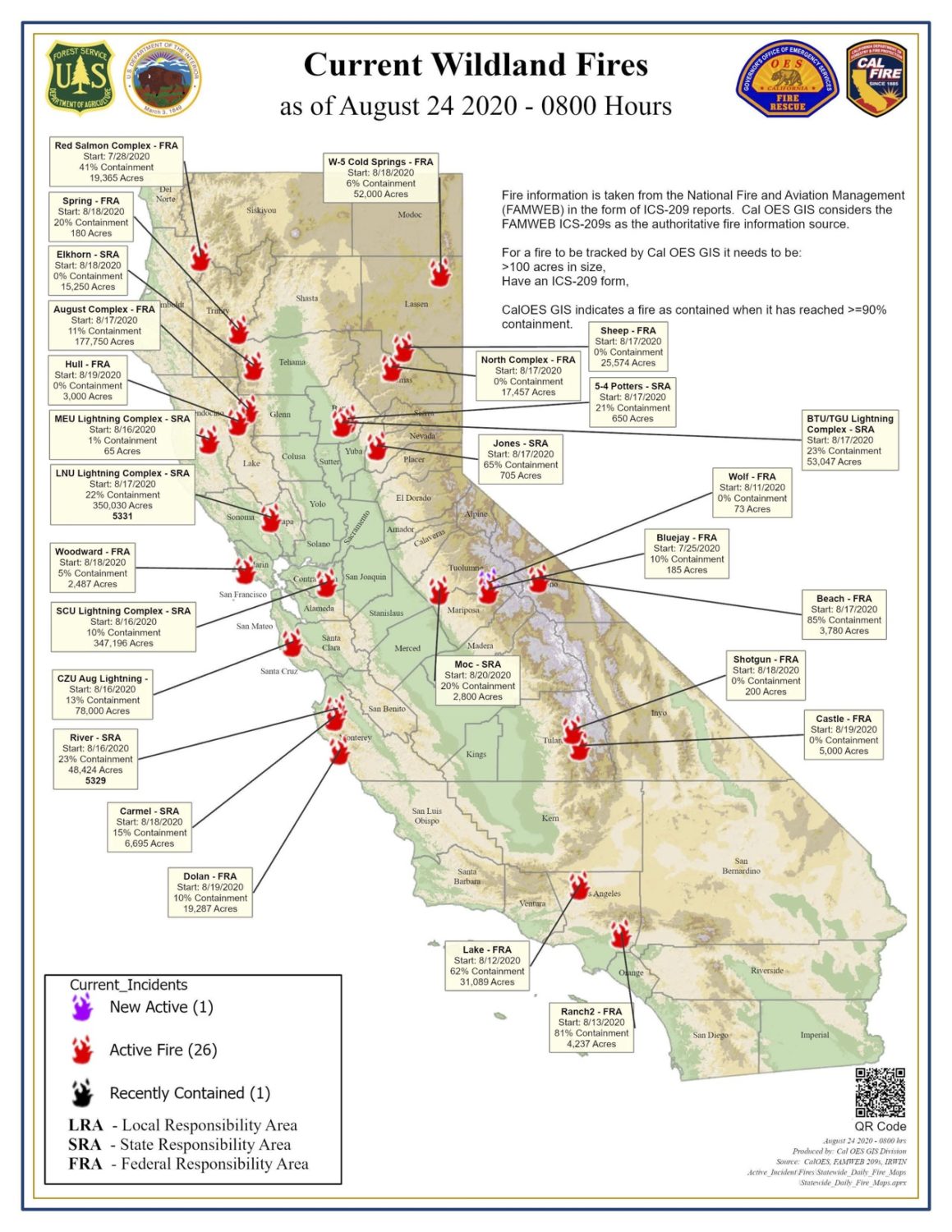As 17 major wildfires continue to rage across California at a historic scale, once again the cannabis industry is feeling the heat close to its annual make-or-break harvest season.
Worst case scenario, crops have been lost to the flames. But the problems trickle down to many other farmers close to the frontlines currently manned by 14,000 firefighters and 2,400 engines as they do their best to save the tens of thousands of structures currently at risk across the state.
This afternoon Gov. Gavin Newsom announced 91 engines from out-of-state have arrived with eight more en route from Montana. The state has requested the mutual aid support of 375 engines. One new factor adding a wrench to the mutual aid requests is two tropical weather systems barreling down on the gulf coast simultaneously. This has certainly left some officials wary of sending their first responders on a cross country road trip. Newsom said the mutual aid has left him mesmerized, especially when he was standing in Livermore the other day as a Santa Monica engine pulled up.
At the end of these road trips, these firefighters likely face some of the largest infernos they’ve ever seen in their careers.
The LNU Lightning Complex in Napa, Sonoma, Lake, Yolo, and Solano counties is the largest of the fires. As of Monday morning, 350,030 acres had burned and it’s currently 22 percent contained. It’s now the second-largest fire in California in nearly 100 years after the Mendocino Complex Fire that torched just over 450,000 acres in the redwoods during the 2018 fire season. Sonoma County is the industrial heart of the Emerald Triangle despite being geographically south. A ton of cannabis gets processed in Santa Rosa, the last big city on Highway 101 until you hit the Oregon border 300+ miles later because it offers the manpower and commercial space to do it at scale.
The SCU Lightning Complex in Santa Clara, Alameda, Contra Costa, San Joaquin, and Stanislaus counties is also wreaking havoc at 347,196 acres and is 10 percent contained. As the cannabis industry went legal, the agricultural flats of places like Salinas, in Monterey County, made a lot more sense than random hillsides when growing at scale. Now all those farms that have popped up in recent years are under a haze created by multiple fires located across the south and east San Francisco bay and into the Santa Cruz Mountains.
The CZU Lightning Complex Fire in Santa Cruz has now devastated the industry to its roots, possibly destroying the Wo/Men’s Alliance for Medical Marijuana, but it doesn’t sound like a full confirmation has been made yet on the status of the farm according to CelebStoner. Information is still hard to come by and verify since so many places in the heart of these fires remain inaccessible.
In addition to the legal operations destroyed – we’ve counted 5 so far – the mountains around Santa Cruz have long been dotted with cultivators participating on the other side of the marketplace. It’s a 100 percent guarantee at this point that for every legal name we hear there will be a couple of folks you won’t hear about. We hope their money was buried deep enough and are pulling for all.
Amongst the farms destroyed was ERB Farms. The farm told David Downs of Leafly, “We thought it was OK and then we started seeing it over the ridge. We were like, ‘Well, the wind’s blowing that way, and it always blows that way.’ But that was not the case. This flowed into the wind.” Over two days the fire pressed toward the farm, eventually destroying it.
ERB Farms took to Instagram to let everyone know they are going to replant this year. They are hoping anyone with clones or teens will be able to help them out. They won’t be doing a GoFundMe as they believe many others will need the support in the coming days.
In the process of asking California NORML if they’d heard anything, we asked what it’s like watching the industry they’ve worked so long to help create get devastated year after year?
“It’s been heartbreaking to watch the cannabis industry go through so many tough challenges, all in a row and year after year,” Ellen Komp, CANORML’s deputy director, told L.A. Weekly. “Losing WAMM would be especially tragic, since it is such a pioneering and compassionate organization, the one on which we modeled SB420 and its medical cannabis cooperative gardens.”
One of the farms that have had to deal with fire many times over the years is 3rd Gen Family in Mendocino. While not always as newsworthy as the Mendocino Complex Fire, plenty of other blazes have given them trouble over the years due to the impact on the wider community infrastructure.
Brandon Parker, the “3rd Gen” in 3rd Gen Family, told L.A. Weekly of the perils of maintaining a steady supply of water once fire season goes into full gear. “You have water handlers running off on you to catch a bigger buck on a fire because they’ll catch a steady income,” Parker said, “Northern California gets down, people make $100,000 a month in the summertime doing that.”
Even when there are no fires, people are running water all night long. “There’s a shortage of water handlers and drivers,” Parker said. “When a fire hits you have an even further shortage of that. So, you know, unless you’re really tied in with these people then they’ll cut you right off right when your plants get going real big start to flower right now.”
While a farm could certainly need a full-time commercial driver to ferry water to its operation, out in the hills, Cal Fire needs dozens of them constantly resupplying the line. “Crops will be droughting out because each of these fires needs 35 or 40 water handlers. That’s always one of the biggest things that sucks when [the fires] hit.”
Parker argued that the conditions created by the smoke and lack of water seemingly make the plants more prone to bugs as they work extra hard to survive the extreme conditions. “The plants have an immune system and they tend to sense when they’re not, you know, on par and the bugs attack when plants are kind of fighting against the conditions,” Parker said.
The final problem Parker noted was the ash. He said with vegetation fires, you still might have a chance at passing testing despite an impact on flavor and quality. But once structures start going up in the flames whole crops can get contaminated above state guidelines with things like arsenic and other nasty construction materials.
Advertising disclosure: We may receive compensation for some of the links in our stories. Thank you for supporting LA Weekly and our advertisers.


